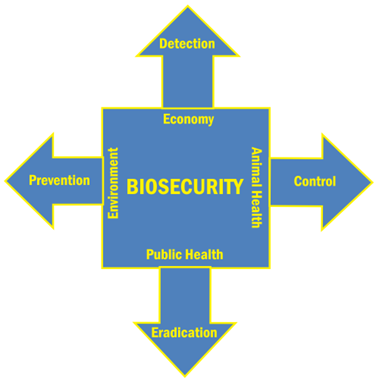8.0 Biosecurity for Aquatic Livestock Production
8.1 Introduction
What is Biosecurity?
The primary goal of biosecurity is to prevent disease. However, when prevention fails, biosecurity becomes a method to detect, separate, control, or eliminate infectious hindrances in the operation of livestock production systems.
Why is Biosecurity Important?
Disease is the largest cause of business failure in aquatic livestock production, which takes a huge investment of money, time, and other resources. When disease enters a facility, it significantly impacts animal welfare, average daily gain, and even the number of animals that make it to market. In addition, treating diseases takes more time, money, and resources. In short, disease has a tremendous impact on the business’s profitability. By utilizing good biosecurity practices, a business can decrease its disease burden, resulting in a better profit margin. As a bonus, good biosecurity not only decreases the number of animals that need to be treated but also the risk of developing antimicrobial resistance by reduction of antimicrobial need and use.
Adequate biosecurity standards prevent disease movement into a facility by disrupting how pests and fomites transport pathogens. Pathogens can enter a production animal system through multiple routes. Entry into a facility can occur via wind currents, water flow, animal movement, people visits, animal traffic, feed delivery, and other means that introduce something foreign to the facility.
Developing a good biosecurity plan is all about finding balance. Balances include keeping the facility isolated yet permitting interdependence with other businesses, preserving animal health yet permitting fresh genetics to be introduced without sharing diseases, maintaining secure biological boundaries yet selling on global markets, and retaining the uniqueness of a healthy population and keeping operations uniform across all health requirements.
There is an international standard of biosecurity to prevent international pathogen movement simultaneously with translocation of animals; however, the term “biosecurity” may not be present verbatim in written documents. The international biosecurity standard is defined in the Sanitary and Phytosanitary Agreement (SPS), founded after the General Agreement on Trade and Tariffs in 1994. The animal health portion of the SPS is under the auspice of the World Organization of Animal Health (WAOH), also previously known as the OIE. The WAOH has determined and published animal movement international trade agreement standards.

The United States has aligned its federal animal health laws with the SPS by enacting the Animal Health Protection Act (AHPA) in 2002. The AHPA is a federal law that standardizes animal movement within the United States. At the federal level, the United States Department of Agriculture (USDA) enacts trade policies on the export of live animals and promulgates regulations on the interstate shipment of animals to prevent pathogen movement with animals. This national level of biosecurity rests on the Veterinary Services within the USDA, which makes regulations regarding “the prevention, detection, control, and eradication of diseases and pests of animals…” (subsequent wording discussed later). Essentially, it boils down to protection from biological harm, which encompasses the health of the animals, preserves the environment, keeps the economy strong, and maintains public health, all of which results in protecting the interstate and foreign commerce of the United States.
With these four points of emphasis in mind, we can better understand the efforts Congress references in the AHPA, as follows:
Congress finds that the prevention, detection, control, and eradication of diseases and pests of animals are essential to protect
- the animal health,
- the public health of the people,
- the economic interests[1] of the United States,
- the environment of the United States, and
- interstate commerce and foreign commerce1 of the United States in animals and other articles.
Keep these protected areas, as outlined by Congress, in mind throughout this chapter. Doing so will keep perspective on a facility’s actions for an effective biosecurity plan (BP). No two facilities will have the same BP. Many common traits will be discussed, but each BP’s implementation and enforcement actions can differ.
In the United States, the states have jurisdiction over animal health and movements within their boundaries. Thus, individual states may have unique animal health requirements. All states require the diagnosis and treatment of animal disease to be done by a licensed veterinary practitioner.
- This author combines economic interests and interstate commerce and foreign commerce as interdependent to simplify this discussion. ↵

